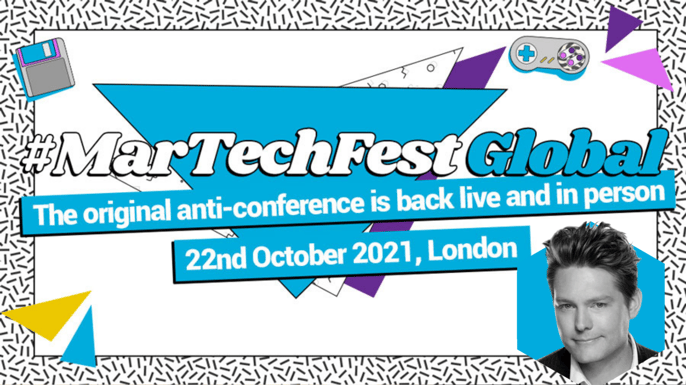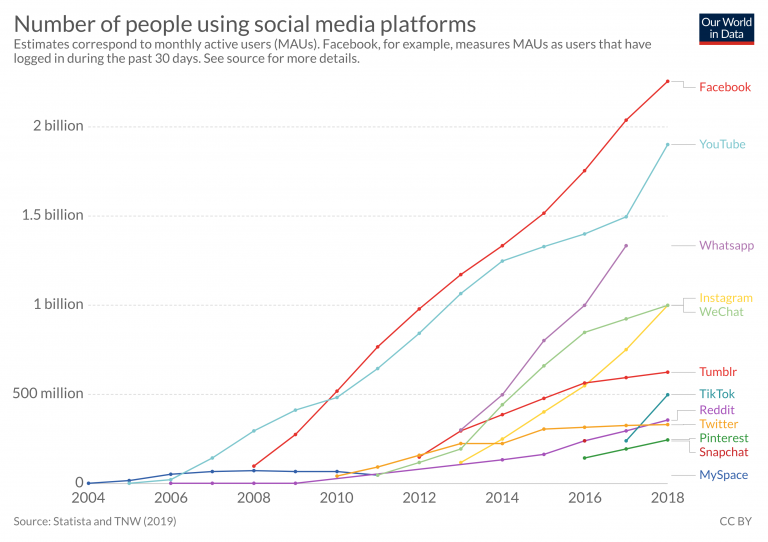Okay, that's a long title.

But how could you begin to sum up Tom Goodwin's presentation in fewer words? Well, "good" might be accurate. "Great" might even work better. "Peerless", maybe. "On fleek", maybe not. "Pretty damn entertaining", definitely.
Tom opened by describing this particular sesh as "interesting but not particularly helpful, so just enjoy it...don't try and write notes". And here we are, writing notes. Sorry Tom.
Tom's job is to understand how the world is changing. But also how it's not changing. And what this means, both in the field of martech, and beyond.
He notes that businesses are told that if you don't disrupt, you die. If you stop swimming, you drown. Everything is changing, and you have to keep up.
Tom likes to test this theory through a 'change safari'. This is a very scientific, "sophisticated technique", where he leaves his apartment...and looks around. Looks at all the things that seem... different.
A sign allowing you to donate to charity using a QR code. A weird bike delivering packages. TikTok. There’s change everywhere. Sometimes there’s a robot outside. It’s delivering food. It doesn’t even have the audacity to overthrow humanity. We're happy to look at our phones at any opportunity - no dignity, no etiquette.
Sometimes you're in a carpet shop in Turkey, and it’s turned into a place to take Instagram photos with a drone”.
Now that one’s relatable.
“Sometimes you’re walking in the Cotswolds and you realise that even people who sell logs have a website” How else would they log in? Log in. Because of the trees. Logs.
“Sometimes you get movies about NFTs...sometimes you see scooters everywhere... sometimes you’re in a church…and you can pay money to the church with a QR code”
With all of this, you could be tempted to panic. You could be tempted to think "oh my god, the world is changing!" But is that really the case?

Time for some science. Showing the audience a grid of "Q’s. Lots of Q’s" and a "grid of O’s. Lots of O’s”, he adds in a few of one into the other.
If you change some of the Q’s to O’s it's hard to see them. If you do the other way round, it's easy to see the Qs. Basically we’re good at seeing additions, evolved to do so. Things that stick out move. Things that move are big and scary, and might like us for dinner.
So, we’re obsessed with everything that’s changing, and not on what’s not. But, as Tom said, you don’t tend to get paid for saying things are staying broadly the same.
There have been more periods of time where things have changed more rapidly. Something as small as the invention of the barbed wire fence has shaped entire cities. Think back to a couple of decades ago, around the time of the smartphone being invented. Suddenly we had a huge period of innovation, with the proliferation of apps, and companies, that are shaping the landscape today.
But since then, not much has changed. Basically, we shouldn't be running around in a mad panic thinking that everything is wildly different, that we have to jump onto every bandwagon in order to keep up.
This is not to say the current climate isn't...strange. The pandemic did have a huge effect on society as a whole.
The price of oil went negative for the first time. GDP growth was wiped out. Things were crazy. There were new changes in behaviour and radical business transformation. In fact, Barclays spent billions putting QR codes in windows. But already, things are returning to normal.
Zoom out and see the context
Just because things changed, it doesn't mean these changes are permanent. We need to be aware that we are obsessed with the ‘real-‘time’, quick world. We always forget to zoom out, see context. Social media can accelerate this. Just remember the coup in Turkey – people on Twitter had actually got it wrong. There was no coup. Imagine just straight up not having an entire coup exist. Madness.
So, when planning for the future, we have to be aware that - broadly – things are going to stay the same. And that’s quite boring to hear that. But it’s true.
Have a look at the broader geographical and political, economic, world. Then zoom in and have a look at the marketing world. Then how our behaviours and expectations are changing. Then using logic, the cone of plausibility, and create a framework in which we can make clear business decisions.
Getting back to the real world
People on stages tend to talk in exceptions. About huge, growth-hacking, disruptive companies, like Apple, Nike, or Patagonia. But they tend to forget the boring aspects of life, that the most commonly bought items are things like vegetable oil and soap. I guess those don't sell event tickets, though.
Basically, marketers talk a lot about encouraging brand loyalty, and loyalty programmes, but the thing is people aren't loyal to brands. Something might be good enough, or bought last time, or we’re tired, or it’s got nice packaging. The main aim for marketers is to get back into the real world, to get back to basics.
The world is chaotic, Tom says, because we just keep adding things on. From martech, to passwords, to streaming platforms and TV, things are added on top of things, to keep up with the pressure of 'progress' - even when it's really not needed, or makes CX worse.
“We Generally treat technology like something to swallow”.
It's treated as a necessity, not something to get excited about. We treat it like “I guess we should have an email address, fuck. Just do some chatbot thing”. We have to get a lot more excited about technology, says Tom.
We tend to just replicate things. For example, in the Metaverse, customers can just go to a store, that looks like a really $hit grocery store, and you can pick things up. It's just popping to Tesco's, but you might also have a pair of wings.
Tech can change everything. But think beyond the novelty
Tom gives the example of the elevator. The elevator allowed for entire cities to be constructed, and the world changed very quickly because of something quite boring.

Electricity, when it was invented, was very exciting. But they didn’t really know what to do with it. Some of the first use cases were Christmas tree lights. It could only really be used as normal lights by very rich people who could afford them, and they had servants to light their lamps anyway.
Only way tech changed lives is when we created new things for the world of technology. Think the radio, the VCR, the tv set, the electric heater. When we build necessary upgrades around a new technology, big things happen. A world of adaptation, a legacy of taking things they used to do, and improving.
Re-think and Re-make
Now, we get to re-think and re-make the world we wanted. But to do that, we need to look at a few things that matter.
- Battle between companies – this is the start-up companies vs legacy, both of which are held to very different standards. The question is - can the tech companies get good at the industry they’re in, before the legacy companies get good at technology.
- Lines are blurring everywhere. This is between the distinction of offline and online. Ordinary people have no idea where that line is. There's a smash together of screens that bring us stuff, and stuff that brings us to screens. Everything in the world becomes something we can buy, usually with a couple of taps. The whole world is a storefront.
- Spoiled consumers. There is an overwhelming expectation that things will be delivered for free, quickly, can be sent back, with no awkwardness. Tom remembered when it used to feel like you were going to court. So, all of the is creating problems for profitability
- Screenification of the world. It is cheaper to buy a 42” tv and display an image, than get an image printed and framed. Everything is becoming screens, and these screens are all connected to the internet.
- This means the media environment becomes one of ecosystems. We need to think less about media channels, and more about consumer journeys. We now have more ways to interact with them, including voice, we now envelop people on a journey. And the more we can think holistically, about what parts of the messaging to send out at what time, how can we build up stories using sequential messaging, how can we connect with people in different contexts.
- Context. For so long media has been about channels, if you now think about it as contexts, which is much more interesting.
- Different shopping flows. A good example is Google Maps using the Uber and Bolt partnership. If you are thinking about advertising as a series of instructions, that’s pulling data from different places which is helpful, that's a good way to think about it. If you think about all the steps consumers make; being bored, looking at Google Maps, looking for a theatre, the availability that night, ordering an Uber to it, sharing that to a friend that they want to take, paying the money for the tickets, it's these kinds of customer flows to think about.
- New interfaces. As part of this moment where we haven’t been that excited about what we can do, we put up with quite bad design. So the value of design has never been more important.
There’s a feeling in the world that it’ll change when this new thing comes along. About 2 years ago, people were saying “oh, when we’ve got 5g, things will be different”, same with IoT, same with 3D printers. The reality is that there’s nothing on the horizon that’s going to change that much, that quickly.
The reality is that this thing in our pocket is the most exciting, most sophisticated device that we’ve ever had to do marketing. Would love to see a bit more urgency, a bit more imagination, a bit more ambition. And that’s why he created his company – a great time to re-think what we do, and how we do it, and get proud of what we accomplish.

